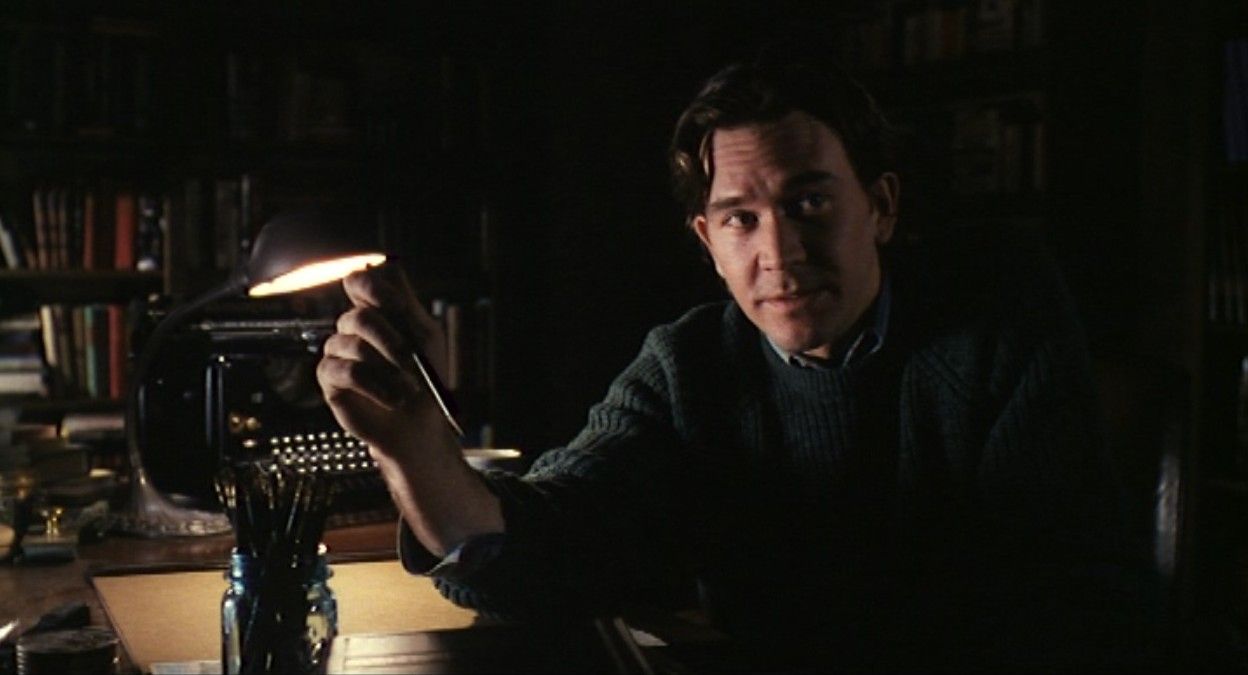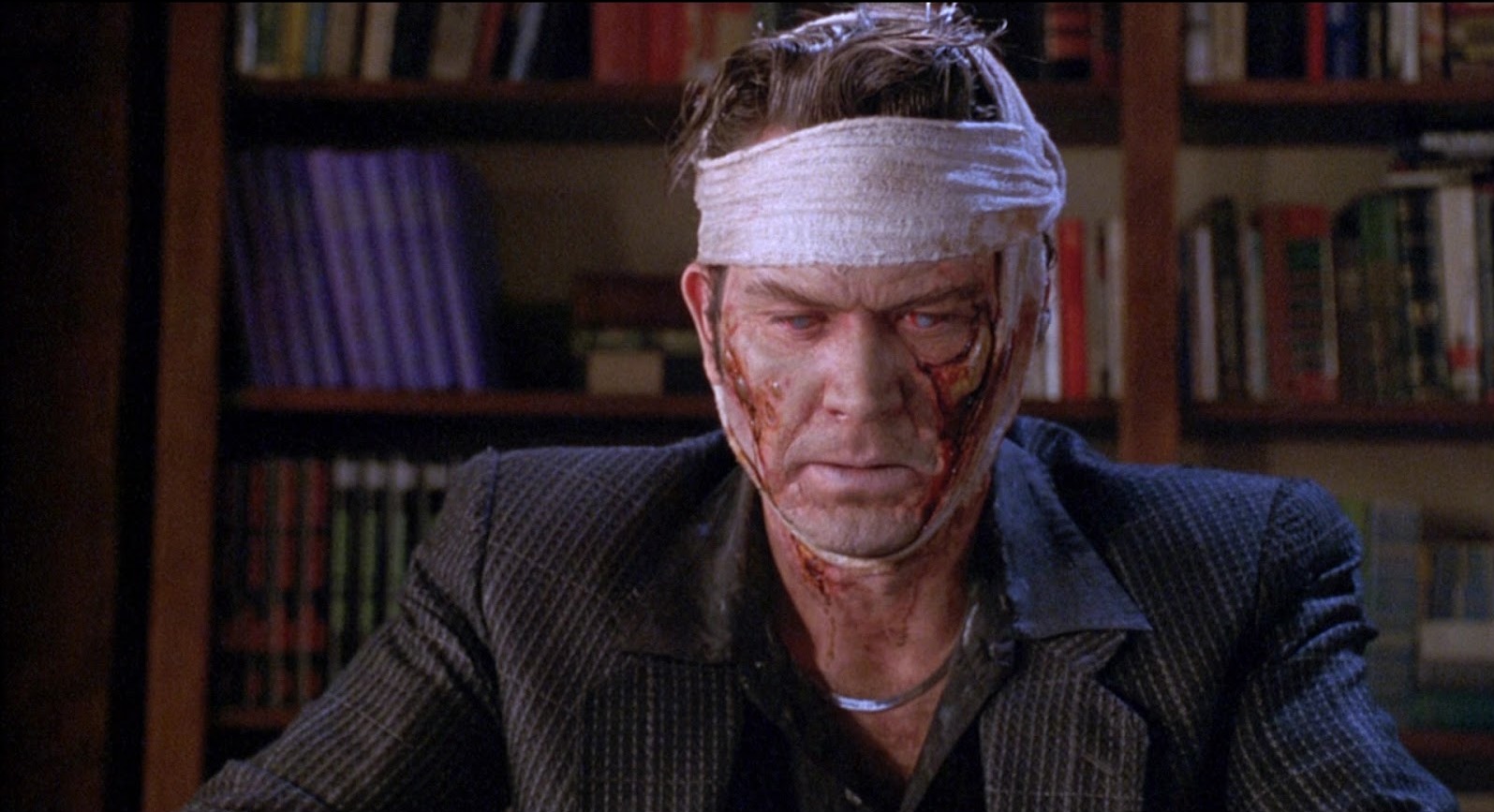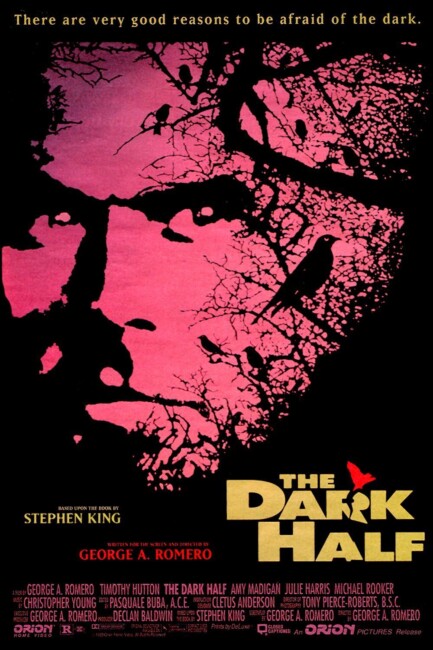USA. 1993.
Crew
Director/Screenplay – George A. Romero, Based on the Novel by Stephen King, Producer – Declan Baldwin, Photography – Tony Pierce-Roberts, Music – Christopher Young, Visual Effects – Visual Concepts Engineering (Supervisor – Kevin Kutchaver), CGI Bird Effects – Video Image, Special Effects Supervisor – Carl Hornier Jr, Makeup Effects – Optic Nerve (Supervisors – Everett Burrell & John Vulich), Production Design – Cletus Anderson. Production Company – Orion.
Cast
Timothy Hutton (Thad Beaumont/George Stark), Amy Madigan (Liz Beaumont), Michael Rooker (Sheriff Alan Pangborn), Julie Harris (Professor Reggie DeLesseps), Kent Broadhurst (Mike Donaldson), Glenn Colerider (Homer Gamache), Tom Mardirosian (Rick Cowley), Rutanya Alder (Miriam Cowley), Robert Joy (Fred Clawson)
Plot
Thad Beaumont, an acclaimed literary writer and creative writing teacher, is approached by Fred Clawson who has worked out that Thad also writes a series of highly popular, ultra-violent thrillers under the nom de plume George Stark. Clawson demands money lest he reveal Thad’s secret. Instead, Thad and his wife call the press and set up a photo op with a fake tomb where they symbolically kill George Stark off. Soon after, police find that the mock grave has been dug up. Next, everybody associated with Stark and the press article starts being violently murdered. Thad makes the realisation that Stark, his dark alter ego, has physically come to life and is now coming after him, demanding that he write a new book.
In his novels of the 1990s, Stephen King has demonstrated a desire to expand his literary range – taking up a much more feminist stance with the likes of Dolores Claiborne (1992), Gerald’s Game (1992) and Rose Madder (1995), while in Misery (1987) and The Dark Half (1989) he examined his own dark side as a writer. Almost all the protagonists in Stephen King’s books are writers so it is not unreasonable to assume there is a reasonable degree of autobiographical content to these latter – Misery deals with obsessive fans and The Dark Half deals with noms de plume and how a writer can be taken over by the dark side they unleash on paper. The Dark Half makes for even more intriguing interpretation when one considers how Stephen King also wrote several books under a nom de plume – Richard Bachman – before this was eventually exposed by a fan Steve Brown in 1982, after which King likewise symbolically killed Bachman off.
The film adaptation of The Dark Half comes from George A. Romero, director of horror classics like Night of the Living Dead (1968), Martin (1976) and Dawn of the Dead (1978). (See below for a full list of George A. Romero’s other genre films). Romero had previously collaborated with Stephen King on a planned but never mounted adaptation of King’s epic The Stand (1978), which then morphed into the EC horror comic homage Creepshow (1982).
The Dark Half is an amazingly faithful adaptation of the novel – in fact, it is probably the most faithful adaptation of any Stephen King novel ever placed on screen. The only changes that George Romero affects in his screenplay are to start the present-day scenes with Fred Clawson threatening to expose Thad (whereas in the book the scene was recounted in flashback) and to change the character of Rawlie De Lesseps from a man to a woman. Some writers would give their eye-teeth for so little in the way of changes.

Certainly, the very faithfulness of the adaptation does magnify some of the novel’s faults. The book is a fast and highly enjoyable read – something that helps cover up the vagueness of King’s explanations for what is going on. However, we are never sure what created George Stark – with everything suggested from brain tumours to unformed twins absorbed into the brain, alter egos come to life and a literal manifestation of Thad’s dark side. Things are no clearer in the film either. Nor is one sure what the sparrows have to do with it all.
While the book is a breathlessly paced read, on the screen George Romero’s pace is somewhat more sedate. The Dark Half is certainly not a bad film but much of the exposition seems directed by Romero in a plain and visually uninteresting manner. The story needs more obsessiveness – it never fully gets inside Timothy Hutton’s boyish looks to show him being haunted by his doppelganger. Although, once the George Stark character emerges on screen in the latter part of the film, things pick up and Romero builds to an impressive climax.
Timothy Hutton is bland as Thad but has clear fun in the George Stark role. Michael Rooker makes for a reasonable version of King’s recurring character of Sheriff Alan Pangborn but his turn in the role was overshadowed by Ed Harris’s triumphant airing of the same role in the adaptation of Stephen King’s Needful Things (1993), which came out the same year as The Dark Half.

The Dark Half was originally completed in 1991 but its release was held up for two years by the financial collapse of Orion Pictures – and when the film did appear it was to mixed reviews and indifferent box-office. George Romero was once seen as one of the most promising genre directors of the 1970s and 80s but vanished almost altogether as a creative force in the 1990s until the renewed interest in zombie films in the mid-00s and he found his second calling beginning with Land of the Dead (2005).
George A. Romero’s other genre films are:- the cult favourite Night of the Living Dead (1968); the suburban witchcraft film Jack’s Wife/Season of the Witch/Hungry Wives (1972); The Crazies (1973), an underrated film about a madness-inducing biospill; The Amusement Park (1975), a surreal allegory about aging; Martin (1976), a superb deconstruction of the cinematic vampire myth; Dawn of the Dead (1978); the Stephen King-scripted horror comic homage Creepshow (1982); Day of the Dead (1985); Monkey Shines (1988), about a psychic link between a paraplegic and a murderous monkey; Two Evil Eyes (1990), an Edgar Allan Poe collaboration with Dario Argento; Bruiser (2000) about a man whose face suddenly becomes a blank mask; Land of the Dead (2005), Diary of the Dead (2007) and Survival of the Dead (2009). Romero has also produced the Tales from the Darkside (1983-5) and Monsters (1988-9) horror anthology series, and the films Deadtime Stories (2009), Deadtime Stories 2 (2010) and the remake of The Crazies (2010). His scripts include Creepshow II (1987), Tales from the Darkside: The Movie His scripts include Creepshow II (1987), Tales from the Darkside: The Movie (1990) and the remake of Night of the Living Dead (1990). Also of interest is George A. Romero’s Resident Evil (2025), a documentary about Romero’s unmade Resident Evil film.
Other Stephen King genre adaptations include:- Carrie (1976), Salem’s Lot (1979), The Shining (1980), Christine (1983), Cujo (1983), The Dead Zone (1983), Children of the Corn (1984), Firestarter (1984), Cat’s Eye (1985), Silver Bullet (1985), The Running Man (1987), Pet Sematary (1989), Graveyard Shift (1990), It (tv mini-series, 1990), Misery (1990), a segment of Tales from the Darkside: The Movie (1990), Sometimes They Come Back (1991), The Lawnmower Man (1992), Needful Things (1993), The Tommyknockers (tv mini-series, 1993), The Stand (tv mini-series, 1994), The Langoliers (tv mini-series, 1995), The Mangler (1995), Thinner (1996), The Night Flier (1997), Quicksilver Highway (1997), The Shining (tv mini-series, 1997), Trucks (1997), Apt Pupil (1998), The Green Mile (1999), The Dead Zone (tv series, 2001-2), Hearts in Atlantis (2001), Carrie (tv mini-series, 2002), Dreamcatcher (2003), Riding the Bullet (2004), ‘Salem’s Lot (tv mini-series, 2004), Secret Window (2004), Desperation (tv mini-series, 2006), Nightmares & Dreamscapes: From the Stories of Stephen King (tv mini-series, 2006), 1408 (2007), The Mist (2007), Children of the Corn (2009), Everything’s Eventual (2009), the tv series Haven (2010-5), Bag of Bones (tv mini-series, 2011), Carrie (2013), Under the Dome (tv series, 2013-5), Big Driver (2014), A Good Marriage (2014), Mercy (2014), Cell (2016), 11.22.63 (tv mini-series, 2016), The Dark Tower (2017), Gerald’s Game (2017), It (2017), The Mist (tv series, 2017), Mr. Mercedes (tv series, 2017-9), 1922 (2017), Castle Rock (tv series, 2018-9), Doctor Sleep (2019), In the Tall Grass (2019), Pet Sematary (2019), The Outsider (tv series, 2020), The Stand (tv mini-series, 2020-1), Chapelwaite (tv series, 2021), Lisey’s Story (tv mini-series, 2021), Firestarter (2022), Mr Harrigan’s Phone (2022), The Boogeyman (2023), The Life of Chuck (2024), Salem’s Lot (2024), The Long Walk (2025), The Monkey (2025) and The Running Man (2025). Stephen King had also written a number of original screen works with Creepshow (1982), Golden Years (tv mini-series, 1991), Sleepwalkers (1992), Storm of the Century (tv mini-series, 1999), Rose Red (tv mini-series, 2002) and the tv series Kingdom Hospital (2004), as well as adapted his own works with the screenplays for Cat’s Eye, Silver Bullet, Pet Sematary, The Stand, The Shining, Desperation, Children of the Corn 2009, A Good Marriage, Cell and Lisey’s Story. King also directed one film with Maximum Overdrive (1986). Stephen King on Screen (2022) is a documentary about King film adaptations.


